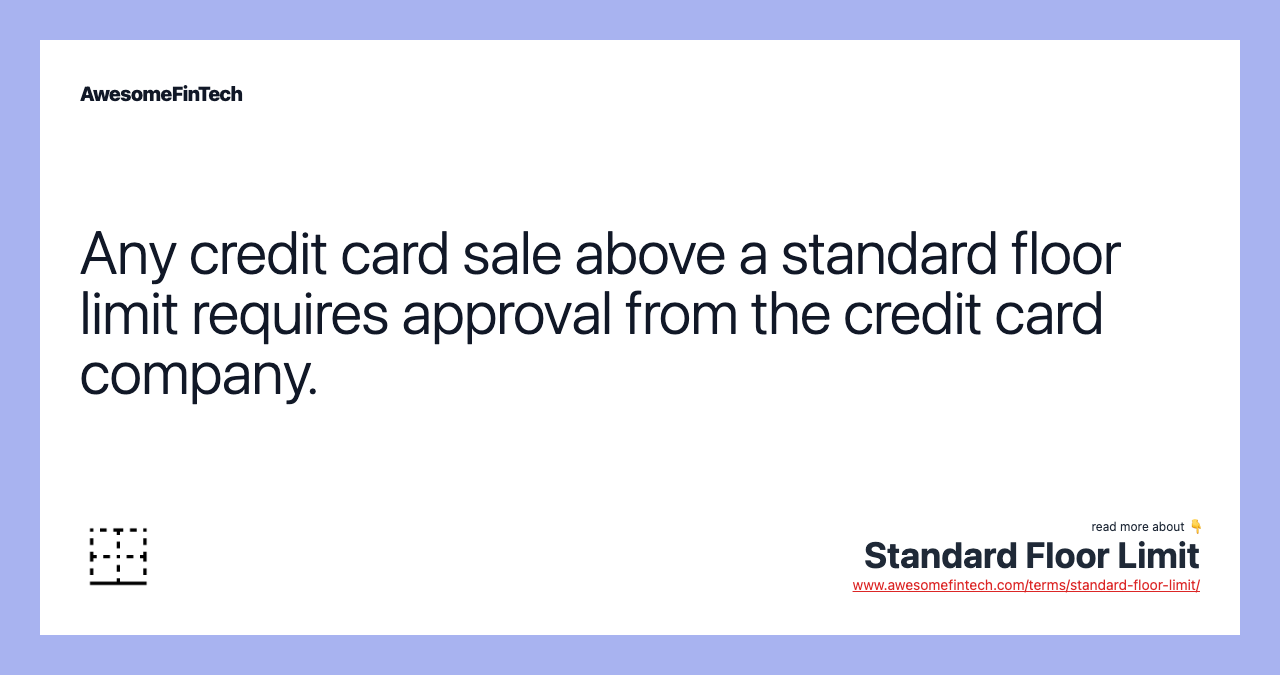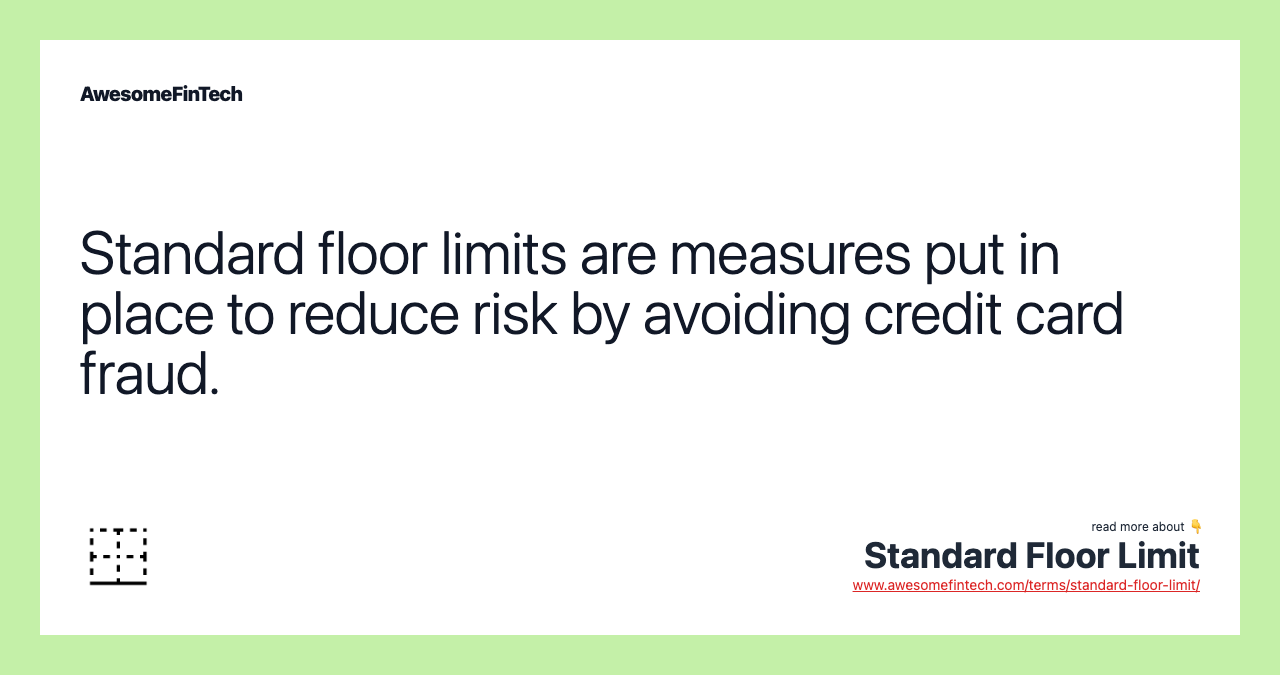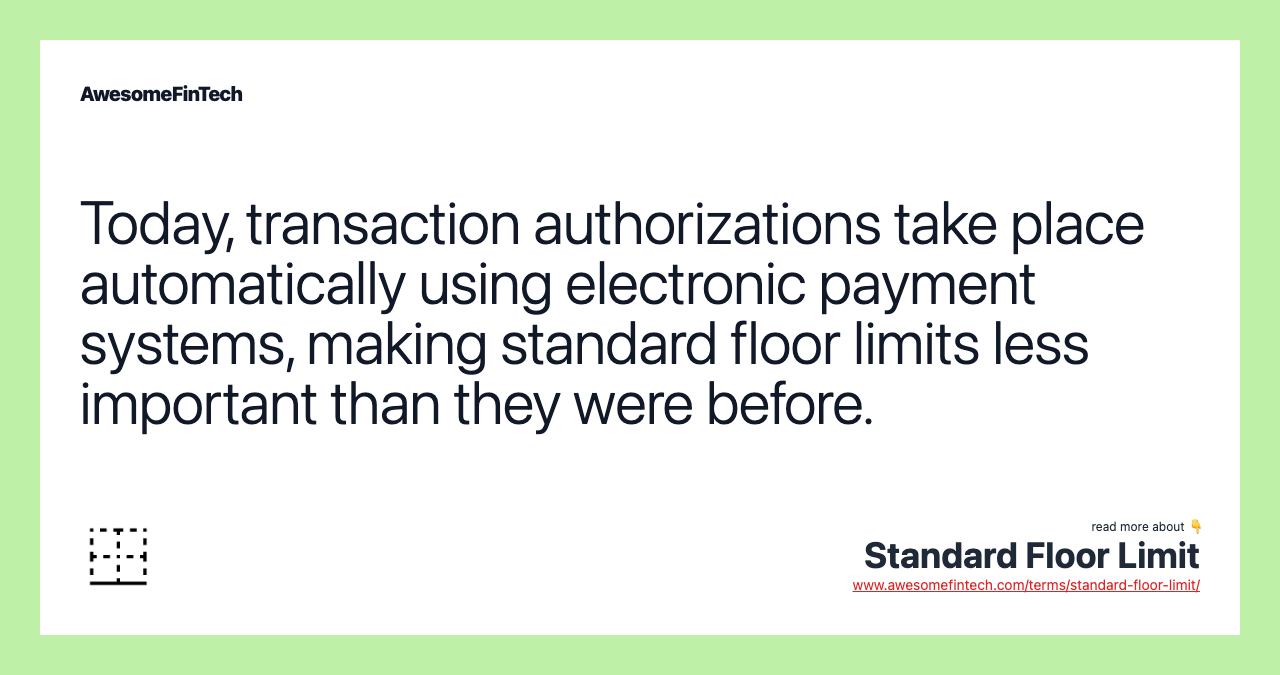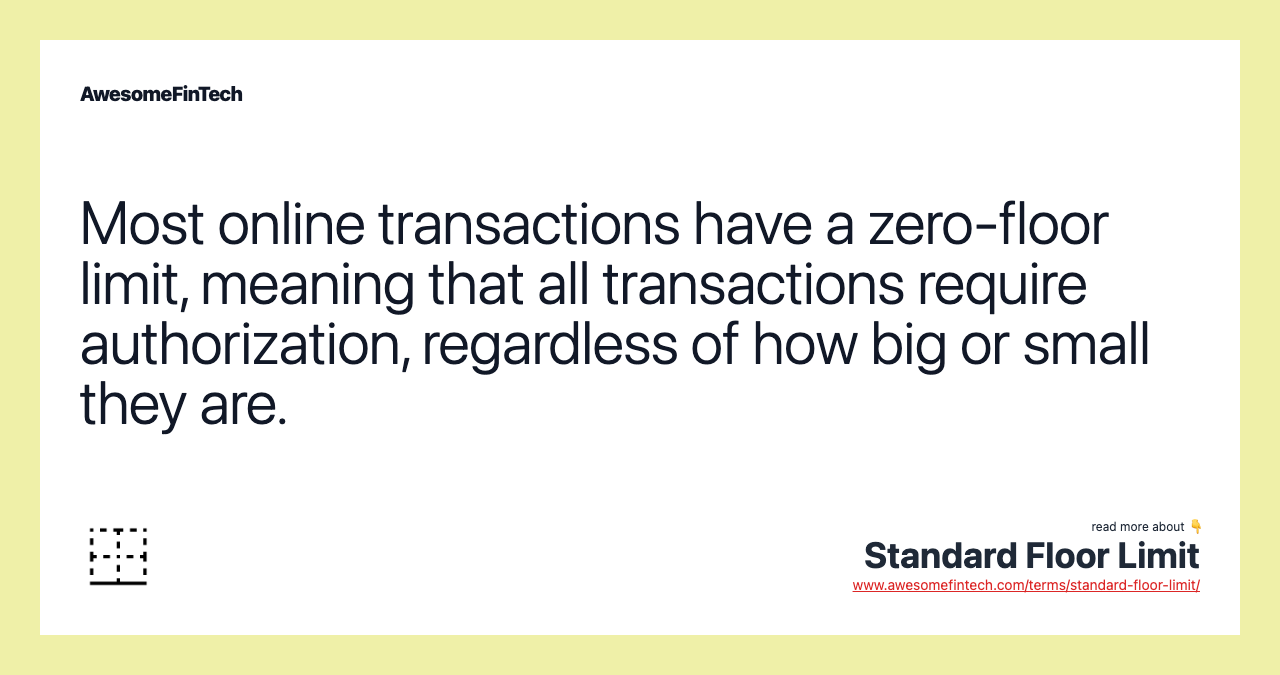Standard Floor Limit
The term "standard floor limit" refers to the transaction size beyond which merchants are required to obtain authorization when processing a credit card transaction. For example, a merchant might have the same floor limit for Visa (V) and MasterCard (MA) transactions, another floor limit for Discover (DFS) transactions, and a third floor limit for American Express (AXP) transactions. When a transaction exceeds the merchant's standard floor limit, the terminal will hold the transaction while the salesperson contacts the credit card company for authorization to ensure that the customer has sufficient credit to complete the purchase. For instance, if a customer attempts to purchase $1,000 in goods in a single transaction from a merchant with a $500 standard floor limit, the credit card company will require contact with the merchant for approval of the charge. Any credit card sale above a standard floor limit requires approval from the credit card company.

What Is a Standard Floor Limit?
The term "standard floor limit" refers to the transaction size beyond which merchants are required to obtain authorization when processing a credit card transaction. For example, a merchant with a standard floor limit of $100 would need to authorize any transaction for more than $100.
Due to the rise of high-speed electronic payment processing systems, standard floor limits are less prominent than they were in the past as merchants can use these electronic systems to communicate with banks directly for approval.





Understanding a Standard Floor Limit
The basic principle behind standard floor limits is to limit the risk of fraud or non-payment associated with each transaction. In theory, a merchant without any standard floor limits could find themselves vulnerable to significant losses if they make large credit sales to their customers. To help mitigate this risk, merchants negotiate standard floor limits with their credit card processing companies, according to which all transactions at or above the designated level will be automatically authorized at the point of sale.
Standard floor limits can vary according to the type of credit card used by the customer. For example, a merchant might have the same floor limit for Visa (V) and MasterCard (MA) transactions, another floor limit for Discover (DFS) transactions, and a third floor limit for American Express (AXP) transactions. For this reason, floor limits can sometimes be a determining factor regarding the types of credit cards a merchant will accept.
Standard Floor Limit Process
When a transaction exceeds the merchant's standard floor limit, the terminal will hold the transaction while the salesperson contacts the credit card company for authorization to ensure that the customer has sufficient credit to complete the purchase.
For instance, if a customer attempts to purchase $1,000 in goods in a single transaction from a merchant with a $500 standard floor limit, the credit card company will require contact with the merchant for approval of the charge. If the customer’s charge is approved, the sale is completed. If it is denied, the merchant may cancel the sale.
Historically, merchants and customers would need to manually record their transactions using manual credit card imprinters. These heavy devices, colloquially known as knuckle-busters, would use carbon paper to make a physical copy of the information embossed on the customer’s credit card. The merchant, in turn, would need to keep track of these carbon copies and use them to painstakingly reconcile their transaction records. Because of this labor-intensive process, it would often take days or even weeks to determine whether a fraudulent transaction occurred.
Electronic Payment Systems and Standard Floor Limits
Technological enhancements have since radically improved the approval process. Today, merchants use electronic point of sale (POS) terminals to process credit card transactions, generating both digital records and printed receipts automatically. These POS terminals can even communicate directly with the customer’s bank and credit card issuer to determine whether the customer has sufficient funds to complete the transaction. In light of this, standard floor limits are less important than they used to be since credit card transactions can now be authorized electronically within seconds of making a purchase.
As terminals with advanced authentication technologies such as microchips, PINs, and magnetic stripes have been deployed more widely in the marketplace, merchants running in-person transactions tend to require much less time authenticating credit card transactions. On the other hand, transactions that are not face-to-face, such as telephone sales or Internet transactions, are often subject to a zero-floor limit. That means that all such transactions require authorization before being approved, regardless of how big or small they are. Approval in this instance, however, can be accomplished quickly.
Related terms:
Authorization Date
The authorization date is the date at which a credit or debit card transaction is approved by the credit card issuer. read more
Card Reader
"Card reader” refers to the technologies used to detect the account number, cardholder information, and authorization code contained on a credit card. read more
Chip Card
A chip card is a plastic debit card or credit card that contains an embedded microchip. The chip encrypts information to increase data security. read more
Credit Card
Issued by a financial company giving the holder an option to borrow funds, credit cards charge interest and are primarily used for short-term financing. read more
Floor Limit
A floor limit—also known as a “credit floor”—is the maximum charge that can be made to a credit card without obtaining prior authorization. read more
Fraud
Fraud, in a general sense, is purposeful deceit designed to provide the perpetrator with unlawful gain or to deny a right to a victim. read more
Knuckle-Buster
Knuckle-buster is a nickname for a manual imprint device, used to record credit card transactions. read more
Luhn Algorithm
The Luhn Algorithm—also known as the “Modulus 10 Algorithm”—is a formula used to determine the accuracy of credit card numbers. read more
Magnetic Stripe Card
A magnetic stripe card is a security device with data embedded in it that identifies the user. It enables secure access, electronic or physical. read more
Payment Gateway
A payment gateway is the front-end technology that reads payment cards and sends customer information to the merchant acquiring bank for processing. read more